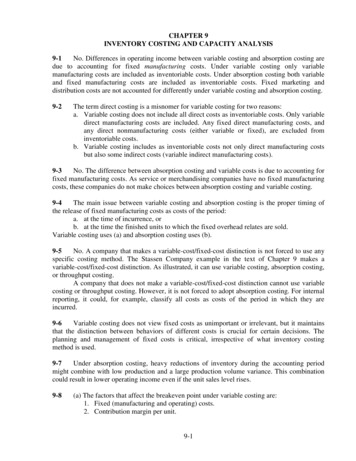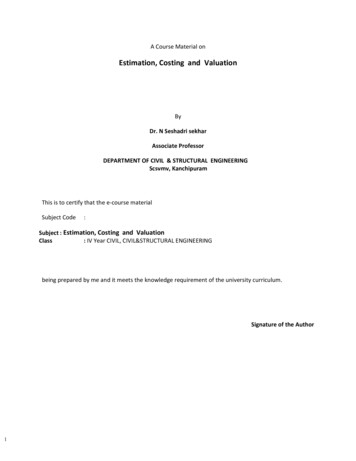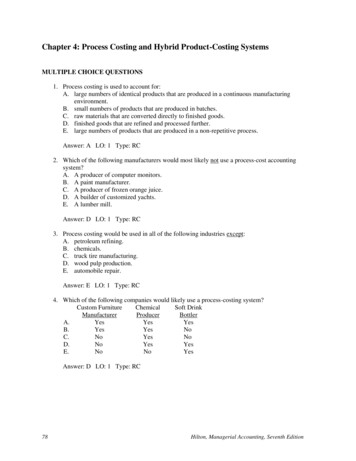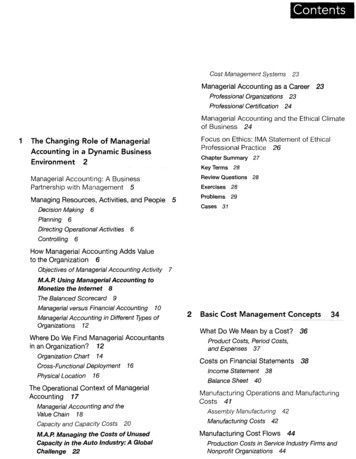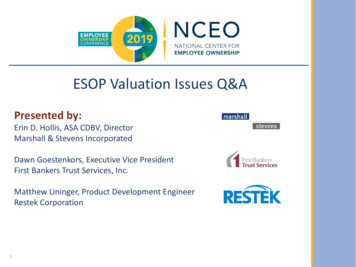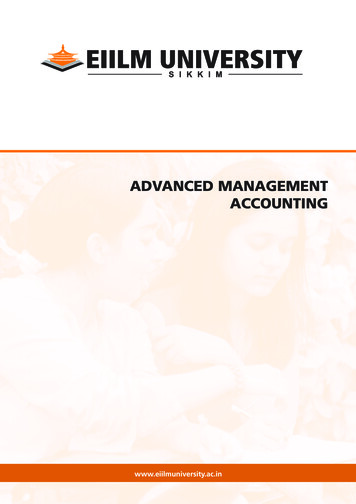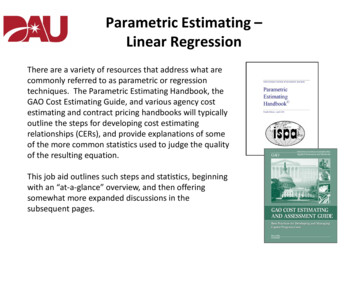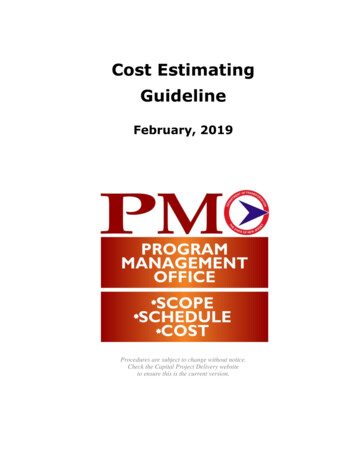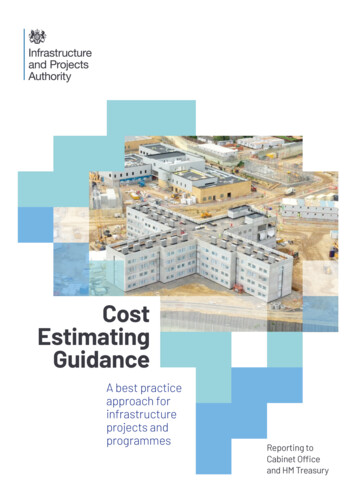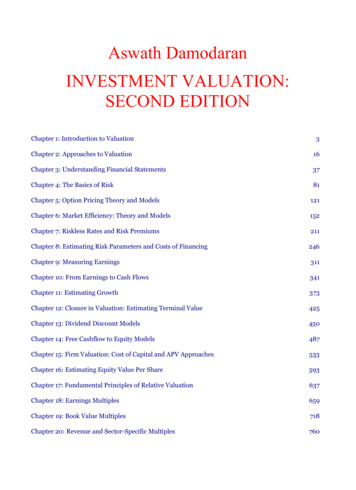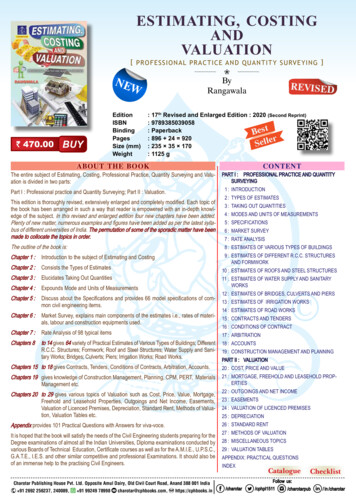
Transcription
ESTIMATING, COSTINGANDVALUATION[ PR O F ES S I O NAL P R AC TI C E AND Q U ANTI TY S U RV EY I N G ] NEByRangawalaW 470.00BUYEditionISBNBindingPagesSize (mm)WeightREVISED: 17th Revised and Enlarged Edition : 2020 (Second Reprint): 9789385039058: PaperbackBest: 896 24 920rSelle: 235 35 170: 1125 gABOUT THE BOOKThe entire subject of Estimating, Costing, Professional Practice, Quantity Surveying and Valuation is divided in two parts:Part I : Professional practice and Quantity Surveying; Part II : Valuation.This edition is thoroughly revised, extensively enlarged and completely modified. Each topic ofthe book has been arranged in such a way that reader is empowered with an in-depth knowledge of the subject. In this revised and enlarged edition four new chapters have been added.Plenty of new matter, numerous examples and figures have been added as per the latest syllabus of different universities of India. The permutation of some of the sporadic matter have beenmade to collocate the topics in order.The outline of the book is:CONTENTPART I : PROFESSIONAL PRACTICE AND QUANTITYSURVEYING1 : INTRODUCTION2 : TYPES OF ESTIMATES3 : TAKING OUT QUANTITIES4 : MODES AND UNITS OF MEASUREMENTS5 : SPECIFICATIONS6 : MARKET SURVEY7 : RATE ANALYSIS8 : ESTIMATES OF VARIOUS TYPES OF BUILDINGS9 : ESTIMATES OF DIFFERENT R.C.C. STRUCTURESAND FORMWORKChapter 1 :Introduction to the subject of Estimating and CostingChapter 2 :Consists the Types of EstimatesChapter 3 :Elucidates Taking Out QuantitiesChapter 4 :Expounds Mode and Units of MeasurementsChapter 5 :Discuss about the Specifications and provides 66 model specifications of common civil engineering items.Chapter 6 :Market Survey, explains main components of the estimates i.e., rates of materials, labour and construction equipments used.Chapter 7 :Rate Analysis of 98 typical itemsChapters 8to 14 gives 64 variety of Practical Estimates of Various Types of Buildings; DifferentR.C.C. Structures; Formwork; Roof and Steel Structures; Water Supply and Sanitary Works; Bridges; Culverts; Piers; Irrigation Works; Road Works.10 : ESTIMATES OF ROOFS AND STEEL STRUCTURES11 : ESTIMATES OF WATER SUPPLY AND SANITARYWORKSChapters 15 to 18 gives Contracts, Tenders, Conditions of Contracts, Arbitration, Accounts.Chapters 19 gives knowledge of Construction Management, Planning, CPM, PERT, MaterialsManagement etc.12 : ESTIMATES OF BRIDGES, CULVERTS AND PIERS13 : ESTIMATES OF IRRIGATION WORKS14 : ESTIMATES OF ROAD WORKS15 : CONTRACTS AND TENDERS16 : CONDITIONS OF CONTRACT17 : ARBITRATION18 : ACCOUNTS19 : CONSTRUCTION MANAGEMENT AND PLANNINGPART II : VALUATION20 : COST, PRICE AND VALUE21 : MORTGAGE, FREEHOLD AND LEASEHOLD PROPERTIESChapters 20 to 29 gives various topics of Valuation such as Cost, Price, Value, Mortgage,Freehold and Leasehold Properties, Outgoings and Net Income, Easements,Valuation of Licenced Premises, Depreciation, Standard Rent, Methods of Valuation, Valuation Tables etc.22 : OUTGOINGS AND NET INCOMEAppendix provides 101 Practical Questions with Answers for viva-voce.26 : STANDARD RENTIt is hoped that the book will satisfy the needs of the Civil Engineering students preparing for theDegree examinations of almost all the Indian Universities, Diploma examinations conducted byvarious Boards of Technical Education, Certificate courses as well as for the A.M.I.E., U.P.S.C.,G.A.T.E., I.E.S. and other similar competitive and professional Examinations. It should also beof an immense help to the practising Civil Engineers.Charotar Publishing House Pvt. Ltd. Opposite Amul Dairy, Old Civil Court Road, Anand 388 001 India 91 2692 256237, 240089, 91 99249 78998charotar@cphbooks.com,https://cphbooks.in23 : EASEMENTS24 : VALUATION OF LICENCED PREMISES25 : DEPRECIATION27 : METHODS OF VALUATION28 : MISCELLANEOUS TOPICS29 : VALUATION TABLESAPPENDIX: PRACTICAL QUESTIONSINDEXCatalogueChecklistFollow us:/charotar/cphpl1511/charotarpub/ in /charotar
ESTIMATING, COSTING AND VALUATIONDETAILED CONTENTSPART I : PROFESSIONAL PRACTICE AND QUANTITYSURVEYINGChapter 1: INTRODUCTION1-1. General1-2. Estimate and estimating1-3. Quantity survey1-4. Essentials of an estimator1-5. Requirements of an estimator1-6. Accompaniments of an estimate1-7. Uses of an estimate1-8. Financial implications1-9. Cost planning1-10. Spot items1-11. Prime cost and provisional sum1-12. Provisional quantities1-13. Day work1-14. Contingencies1-15. Work-charged establishment1-16. Regular establishment1-17. Schedule of rates (S.O.R.)1-18. Estimated cost and construction cost1-19. Water and electric consumption charges1-20. Overhead chargesQuestions 1Chapter 2: TYPES OF ESTIMATES2-1. Types of estimates2-2. Detailed estimate2-3. Types of detailed estimates2-3-1. Quantity estimate or item rate estimate2-3-2. Revised estimate2-3-3. Supplementary estimate2-3-4. Revised and supplementary estimate2-3-5. Complete estimate2-3-6. Annual maintenance and repair estimate2-3-7. Special repair estimate2-4. Approximate estimate2-5. Approximate methods of costing for various structures2-5-1. Methods of approximate costing for Buildings2-5-2. Methods of approximate costing for Steel bridges2-5-3. Methods of approximate costing for R.C.C. retaining walls2-5-4. Methods of approximate costing for Highways and roads2-5-5. Methods of approximate costing for Dams2-5-6. Methods of approximate costing for Culverts2-5-7. Methods of approximate costing for Irrigation canals2-5-8. Water supply and sanitary projectsQuestions 2Chapter 3: TAKING OUT QUANTITIES3-1. General3-2. Meaning of the term taking out quantities3-3. Methods of taking out quantities3-4. Methods of computing quantities3-4-1. Centre-line method3-4-2. Crossings method3-4-3. Out-to-out and in-to-in method or long wall and short wallmethod3-5. Deductions for opening in masonry3-6. Theory of arch3-7. Volume of concrete in trapezoidal footingQuestions 3Chapter 4: MODES AND UNITS OF MEASUREMENTS4-1. Introduction4-2. Principles for Units of measurements4-3. General rules for measurements4-4. Degree of accuracy4-5. Modes of measurement for different items4-5-1. Preliminaries4-5-2. Excavation4-5-3. Concrete work4-5-4. Brickwork4-5-5. Stonework4-5-6. Woodwork4-5-7. Plaster work4-5-8. Pointing4-5-9. Floor finishes4-5-10. Whitewashing, colour-washing and distempering4-5-11. Painting4-5-12. Steel and iron work4-5-13. Water supply connections4-5-14. Drainage connections4-5-15. Road-work4-6.Units of measurementsQuestions 4Chapter 5: SPECIFICATIONS5-1.General5-2.Definition5-3.Objects of specifications5-4.Importance of specifications5-5.Use of specifications5-6.Types of specifications5-6-1. Brief specifications5-6-2. Detailed specifications5-7.Classification of specifications5-8.Design of specifications5-9.Important aspects of the design of a specification5-10. Principles of specification writing5-11. Sources of information5-12. Typical specifications5-12-1. Specification for excavation5-12-2. Specification for removal of water from foundations5-12-3. Specification for damp proof course5-12-4. Specification for brickbat lime concrete for foundation inproportion (1:2:4)5-12-5. Specification for 1st class brickwork in c.m. (1:6)5-12-6. Specification for timber doors and windows5-12-7. Specifications for steel doors and windows5-12-8. Specification for bricknogged partition in c.m. (1:4)5-12-9. Specification for random rubble masonry5-12-10. Specification for coursed rubble masonry5-12-11. Specification for ashlar masonry in c.m. (1:3)5-12-12. Specification for R.C.C. work proportion (1:2:4)5-12-13. Specification for reinforced brick-work for slab of one brickdepth5-12-14. Specification for terrazo finish5-12-15. Specification for marble flooring5-12-16. Specification for polished Kotah machine cut stone paving5-12-17. Specification for brick on edge flooring5-12-18. Specification for cement concrete flooring in proportion5-12-19. Specification for pointing in c.m. (1:1)5-12-20. Specification for 20 mm sand faced cement plaster5-12-21. Specification for 18 mm thick single coat mala plaster5-12-22. Specification for whitewashing in three coats5-12-23. Specification for painting in three coats5-12-24. Specification for French polish5-12-25. Specification for wax polish5-12-26. Specification for suspended ceiling of plaster of Paris5-12-27. Specification for Manglore-tiled roof5-12-28. Specification for cast-iron articles5-12-29. Specification for fixing asbestos cement corrugated roofingsheets on steel purlins5-12-30. Specification for fixing 1 mm thick corrugated galvanizediron sheets on wooden purlins5-12-31. Specification for driving precast R.C.C. piles5-12-32. Specification for uncased cast-in-situ R.C.C. piles5-12-33. Specification for providing and laying 150 mm diameter S.W.pipe5-12-34. Specification for providing and laying 900 mm diameterR.C.C. hume pipe5-12-35. Specification for 160 mm water-bound macadam road forheavy traffic5-12-36. Specification for 50 mm full grout surface on an existingroadCharotar Publishing House Pvt. Ltd. Opposite Amul Dairy, Old Civil Court Road, Anand 388 001 India 91 2692 256237, 240089, 91 99249 ow us:/charotar/cphpl1511/charotarpub/ in /charotar
ESTIMATING, COSTING AND VALUATIONDETAILED CONTENTS5-12-37. Specification for earthwork for road in embankment5-12-38. Specification for lightening conductor5-12-39. Specification for cast iron pipes5-12-40. Specification for supplying and fixing Indian type W.C. withfoot rest5-12-41. Specification for providing and fixing European type W.C.5-12-42. Specification for providing and fixing wash basin includingall fittings5-12-43. Specifications for supplying, laying and fixing galvanizediron pipes5-13. Specifications in outlines5-13-1. Specification for the brickwork in arch in c.m. (1:4)5-13-2. Specification for 2nd class brickwork in c.m. (1:6)5-13-3. Specification for 3rd class brickwork in c.m. (1:6)5-13-4. Specification for the brick partition wall in c.m. (1:4)5-13-5. Specification for reinforced brickwork for walls in c.m. (1:3)5-13-6. Specification for coursed rubble masonry I sort in c.m. (1:6)5-13-7. Specification for coursed rubble masonry II sort in c.m. (1:6)5-13-8. Specification for coursed rubble masonry III sort in c.m.(1:6)5-13-9. Specification for R.C.C. slab 12 cm thick prop. (1:2:4)5-13-10. Specification for R.C.C. beam prop. (1:2:4)5-13-11. Specification for R.C.C. stair of 1 metre width prop. (1:2:4)5-13-12. Specification for 40 mm thick Indian patent stone prop.(1:2:4)5-13-13. Specification for wooden cupboards5-13-14. Specification for 12 mm thick cement plaster in c.m. (1:4)5-13-15. Specification for manhole of size 1 m 1 m and depth notexceeding 2 m5-13-16. Specification for centrifugal pumps5-13-17. Specification for mosaic tiles flooring5-13-18. Specification for 80 mm full grout surface on existing road5-13-19. Specification for 50 mm thick asphaltic concrete road surface5-13-20. Specification for 150 mm thick cement concrete road (1:2:4)laid in single layer5-13-21. Specification for cement macadam road on existing W.B.road surface5-13-22. Specification for fabricating steel roof truss by welding5-13-23. Specification for earthwork for road in cuttingQuestions 5Chapter 6: MARKET SURVEY6-1.General6-2.Significance of market survey6-3.Rates of materials6-4.Rates of labour6-5.Construction equipments6-5-1. Importance6-5-2. Selection of equipments6-5-3. Economic life of construction equipments6-5-4. Sources of equipments6-5-5. Various types of construction equipments6-5-5-1. Excavating and earth moving equipments6-5-5-2. Earth compacting equipments6-5-5-3. Hauling equipments6-5-5-4. Hoisting equipments6-5-5-5. Conveying equipments6-5-5-6. Pumping equipments6-5-5-7. Concrete construction equipments6-5-5-8. Drilling equipments6-5-5-9. Road making equipments6-5-6. Tools used in brick masonry, stone masonry and plaster workQuestions 6Chapter 7: RATE ANALYSIS7-1.Definition7-2.Purposes of rate analysis7-3.Importance of rate analysis7-4.Essentials of rate analysis7-5.Schedule of rates (S.O.R.)7-6.Standard costing7-7.Task work per day7-8.Rate analysis of typical 8-37.7-8-38.7-8-39.7-8-40.Excavation for foundation in ordinary soft soil includingthrowing excavated earth within the lead of 30 m and liftof 1.50 mSand filling in plinthBrickbat cement concrete (B.B.C.C.) proportion(1:6:12) forfoundations and plinthBrickbat cement concrete (B.B.C.C.) proportion (1:5:10) forfoundations and plinthBrickbat cement concrete (B.B.C.C.) proportion (1:4:8) forfoundations and plinthBrickbat cement concrete for foundations proportion (1:3:6)for foundations and plinth65 mm thick brickbat coba concrete proportion (1:6:12) underterrace floorsBrickbat lime concrete (B.B.L.C.) proportion (1:2:4) forfoundations and plinthPlain cement concrete (P.C.C.) proportion (1:6:12) belowcolumn footing in foundationsPlain cement concrete proportion (1:4:8) below column footingin foundationsPlain cement concrete (P.C.C.) proportion (1:3:6)Plain cement concrete (P.C.C.) proportion (1:2:4) M15Plain cement concrete (P.C.C.) proportion (1:1.5:3) M20Plain cement concrete (P.C.C.) proportion (1:1:2) M25Providing and laying Mild steel reinforcementProviding and laying HYSD steel reinforcement12 cm R.C.C. slab proportion (1:2:4) M15 with steelreinforcementR.C.C. beams proportion (1:2:4) M15 with steel reinforcementR.C.C. columns proportion (1:2:4)M15 with steel reinforcementR.C.C. Lintels proportion (1:2:4)M15 with steel reinforcementR.C.C. footing proportion (1:2:4)M15 with steel reinforcementR.C.C. coping proportion (1:2:4)M15 with steel reinforcementR.C.C. plinth beam proportion (1:2:4)M15 with steel reinforcement112.5 mm thick R.C.C. cantilever slab proportion (1:2:4)M15 with steel reinforcementAverage 75 mm thick R.C.C. weathershed proportion (1:2:4)M15 with steel reinforcement1.0 m wide R.C.C. step proportion (1:2:4) M15 with steelreinforcementAverage 75 mm thick R.C.C. paradi proportion (1:2:4) M15with steel reinforcementAverage 125 mm thick R.C.C. canopy slab proportion (1:2:4)M15 with steel reinforcement12 cm R.C.C. slab proportion (1:1.5:3) M20 with steelreinforcementR.C.C. beam proportion (1:1.5:3) M20 with steel reinforcementR.C.C. column proportion (1:1.5:3) M20 with steelreinforcementR.C.C. lintel proportion (1:1.5:3) M20 with steel reinforcement0R.C.C. footing proportion (1:1.5:3) M20 with steelreinforcementR.C.C. coping proportion (1:1.5:3) M20 with steelreinforcementR.C.C. plinth beam proportion (1:1.5:3) M20 with steelreinforcement112.5 mm thick R.C.C. cantilever slab proportion (1:1.5:3)M20 with steel reinforcementAverage 75 mm thick R.C.C. weathershed proportion(1:1.5:3) M20 with steel reinforcement1.0 m wide R.C.C. step proportion (1:1.5:3) M20 with steelreinforcementAverage 75 mm thick R.C.C. Pardi proportion (1:1.5:3) M20with steel reinforcementAverage 125 mm thick R.C.C. Canopy slab proportion(1:1.5:3) M20 with steel reinforcementCharotar Publishing House Pvt. Ltd. Opposite Amul Dairy, Old Civil Court Road, Anand 388 001 India 91 2692 256237, 240089, 91 99249 ow us:/charotar/cphpl1511/charotarpub/ in /charotar
ESTIMATING, COSTING AND VALUATIONDETAILED CONTENTS7-8-41. 1st class brickwork in cement mortar (1:6) upto plinth usingmodular bricks7-8-42. 1st class brickwork in c.m. (1:6) upto plinth using conventionalbricks7-8-43. 1st class brickwork in c.m. (1:8) upto plinth7-8-44. 10 cm thick brick partition wall in c.m. (1:4) for groundfloor7-8-45. Ashlar masonry in c.m. (1:6) for ground floor7-8-46. Coursed rubble masonry in c.m. (1:6) for ground floor7-8-47. Random rubble masonry in c.m. (1:6) for ground floor7-8-48. Brickwork in arch with c.m. (1:3) using modular bricks7-8-49. Honey comb brickwork for partition wall in c.m. (1:4) insuperstructure7-8-50. Cement mortar (1:1) (1 Cement : 1 Sand)7-8-51. Cement mortar (1:2) (1 Cement : 2 Sand)7-8-52. Cement mortar (1:3) (1 Cement : 3 Sand)7-8-53. Cement mortar (1:4) (1 Cement : 4 Sand)7-8-54. Cement mortar (1:5) (1 Cement : 5 Sand)7-8-55. Cement mortar (1:6) (1 Cement : 6 Sand)7-8-56. Lime mortar (1:2) (1 Lime Putty : 2 Fine Sand)7-8-57. Mosaic tiles (precast terrazzo tiles) flooring on average 25mm thick bedding of c.m. (1:4)7-8-58. Mosaic tiles flooring on terrace7-8-59. Mosaic tiles skirting 75 mm high7-8-60. Polished Kotah stone flooring7-8-61. Poilshed Kotah stone skirting 75 mm high7-8-62. White glazed tiles flooring of size 150 mm 150 mm7-8-63. White glazed tiles in skirting, risers of step and dado on 12mm thick rough cement plaster (1:3) base and joined withwhite cement slurry7-8-64. 40 mm thick Indian patent stone in P.C.C. (1:2:4)7-8-65. 62 mm thick I.P.S. with ironite finish, 50 mm thick P.C.C.(1:2:4) and 12 mm thick ironite finish7-8-66. Rough Kotah stone flooring on average 40 mm thick bedding7-8-67. Marble flooring7-8-68. Marble skirting 75 mm high7-8-69. 40 mm thick terrazo floor finish7-8-70. Crazy Marble Stone Flooring7-8-71. P.V.C. Tiles Flooring7-8-72. Flooring of bricks on edge–top 25 mm in c.m. (1:1) and restin c.m. (1:24)7-8-73. Light weight thor concrete in proportion (1:6:36) (1 cement:2 sand: 6 brickbats: 36 light weight thor)7-8-74. 75 mm 75 mm size cement grit vata in proportion (1:2:4)(volume per 10 m 0.075 0.075 10 0.06 cu m)7-8-75. Cut cement pointing in c.m. (1:1)7-8-76. 12 mm thick cement plaster in c.m. (1:4)7-8-77. 12 mm thick cement plaster in c.m. (1:3)7-8-78. 18 mm thick single coat mala plaster in c.m. (1:4)7-8-79. 20 mm thick double coat sand faced plaster with 1st coat inc.m. (1:4) and 2nd coat in c.m. (1:2)7-8-80. 20 mm thick double coat sand faced plaster with 1st coat inc.m. (1:4) and 2nd coat in c.m. (1:1)7-8-81. Whitewashing in three coats7-8-82. Oil painting in three coats7-8-83. Fully panelled double shutter wooden door of size 1.10 m 2.00 m with brass fastenings and fixtures7-8-84. Fully glazed double shutter window of size 1.00 m 1.50m with brass fastenings and fixtures7-8-85. Manglore-tiled roof including wooden battens 45 cm 25mm at 350 mm centre to centre7-8-86. Laying G.I. Pipe 40 mm diameter (Open)7-8-87. Laying G.I. pipe 40 mm diameter (concealed)7-8-88. Laying 150 mm diameter stoneware pipe7-8-89. Washbasin of size 550 mm 400 mm7-8-90. Indian W.C. of size 580 mm with a pair of foot-rest7-8-91. Suspended ceiling of Plaster of Paris including wooden mainbattens 100 mm 50 mm at 80 cm c/c and cross battens 50mm 25 mm at 40 cm c/c7-8-92. Rubble soling 12 cm thick7-8-93. 150 mm thick water bound macadam road surface7-8-94.7-8-95.7-8-96.7-8-97.7-8-98.50 mm full grout surface on existing road surface20 mm thick Damp-poof course in c.m. (1:2)25 mm thick Damp-poof course in cement concrete proportionConcealed electric light point of M.S. conduitConcealed electric light point of P.V.C. conduit upto averageheight 3.05 m7-9.Rates for some typical items of constructionQuestions 7Chapter 8: ESTIMATES OF VARIOUS TYPES OF BUILDINGS8-1.General8-2.Estimate of simple steps8-3.Estimate of corner steps8-4.Estimate of a shop8-5.Estimate of a servant’s quarter8-6.Estimate of a sanitary block for a factory building8-7.Estimate of a residential building8-8.Estimate of a children’s library8-9.Estimate of a compound wall8-10. Estimate of a ginning factory8-11. Typical estimates of buildingsChapter 9: ESTIMATES OF DIFFERENT R.C.C. STRUCTURESAND FORMWORK9-1.General9-2.Quantity of steel9-3.Weights of steel bars9-4.Number of bars or stirrups9-5.Types of steel bars9-6.Length of hook and bent-up bars9-7.Bar bending schedule9-8.Estimate of R.C.C. column with footing in prop. (1:1.5:3)9-9.Estimate of R.C.C. Beam in proportion (1:1.5:3)9-10. Estimate of R.C.C. beam in proportion (1:1.5:3)9-11. Estimate of R.C.C. Weathershed with lintel for 1.20 m widewindow in proportion (1:1.5:3)9-12. Estimate of R.C.C. Slab in proportion (1:1.5:3)9-13. Estimate of R.C.C. Floor in proportion (1:1.5:3)9-14. Estimate of formwork for R.C.C. Works9-15. Estimate of R.C.C. Retaining wall in proportion (1:1.5:3)9-16. Estimate of R.C.C. Retaining wall9-17. Estimate of a shed for cycles9-18. Estimate of R.C.C. StaircaseChapter 10: ESTIMATES OF ROOFS AND STEEL STRUCTURES10-1. General10-2. Estimate of a roof with corrugated galvanized iron sheets10-3. Estimate of a welded steel roof truss10-4. Estimate of a steel stanchion with grillage foundationChapter 11: ESTIMATES OF WATER SUPPLY AND SANITARYWORKS11-1. General11-2. Estimate of an underground storage tank (only in bricks)11-3. Estimate of brick cum R.C.C. type underground water storagetank11-4. Estimate of an overhead R.C.C. water storage tank11-5. Septic tanks11-6. Design of a septic tank and a soak well11-7. Estimate of a septic tank with soak well11-8. Estimate of a septic tank11-9. Estimate of a septic tank with three compartmentsChapter 12: ESTIMATES OF BRIDGES, CULVERTS AND PIERS12-1. General12-2. Estimate of a pier12-3. Estimate of a railway culvert12-4. Estimate of a hume pipe culvert12-5. Estimate of a hume pipe culvert12-6. Estimate of a pipe culvert12-7. Estimate of a slab culvert12-8. Estimate of a road bridge12-9. Estimate of a splayed wing wallCharotar Publishing House Pvt. Ltd. Opposite Amul Dairy, Old Civil Court Road, Anand 388 001 India 91 2692 256237, 240089, 91 99249 ow us:/charotar/cphpl1511/charotarpub/ in /charotar
Chapter 13: ESTIMATES OF IRRIGATION WORKS13-1. General13-2. Estimate of a cushion type fall13-3. Estimate of a canal fall13-4. Estimate of a hume pipe head regulator13-5. Estimate of an earthen damChapter 14: ESTIMATES OF ROAD WORKS14-1. General14-2. Computation of volume by corss-sections14-2-1. Level section14-2-2. Two-level section14-2-3. Side hill two-level section14-2-4. Three-level section14-2-5. Multi-level section14-3. Computation of volume of earthwork14-3-1. Mid-sectional area method14-3-2. Mean-sectional area method14-3-3. Trapezoidal formula14-3-4. Prismoidal formula14-3-5. Spot levels14-4. Typical estimates of road work14-5. Estimate of Earthwork of a road in cutting14-6. Estimate of Earthwork of a road partly in cutting and partlyin embankment14-7. Estimate of Earthwork of a road in plain14-8. Estimate of earthwork for a road using mid-sectional area method14-9. Estimate of earthwork for a road using mid-sectional area andmean sectional area method14-10. Estimate of earthwork for a road using mid-sectional area method14-11. Estimate of earthwork for a road using prismoidal formula14-12. estimate of earthwork for a road using trapezoidal formula14-13. Estimate of earthwork for a small pond14-14. Estimate of earthwork for a road partly in cutting and partlyin filling14-15. Estimate of earthwork of a road in embankment14-16. Estimate of earthwork of a curved road in embankmentChapter 15: CONTRACTS AND TENDERSCONTRACTS15-1. Definitions15-2. Essential requirements or elements of a valid contract15-3. Trade usages15-4. Forms of contract15-4-1. Lump-sum contracts15-4-2. Unit-price or item-rate contracts15-4-3. Cost-plus or percentage contracts15-4-4. Basic price contracts15-5. Types of contracts15-6. Termination of contracts15-7. Contract documents15-8. Qualification of contractors15-8-1. Post-qualification of contractors15-8-2. Pre-qualification of contractors15-8-3. Independent contractor15-8-4. Irresponsible contractor15-9. Responsibilities of different agencies15-10. Contract between owner and engineer15-11. Work executed without a contractTENDERS15-12. Meaning of tender15-13. Classification of tenders15-14. Tender notice15-15. Advertisement of tender15-16. Tender form15-17. Mode of submission of tender15-18. Opening of tenders15-19. Scrutiny of tenders15-20. Acceptance of tender15-21. Revocation of tender15-22. Unbalanced tender15-23. Liquidated damages15-24. Mobilization fund15-25. Direct and indirect costsQuestions 15Chapter 16: CONDITIONS OF CONTRACT16-1. Definition16-2. Object16-3. Importance16-4. Peculiarities16-5. General provisions16-6. Typical clauses of the conditions of contract16-7 Escalation clause16-8. Conditions of contract in outlinesQuestions 16Chapter 17: ARBITRATION17-1. General17-2. Definition17-3. Matters for reference to arbitration17-4. Kinds of arbitration17-5 Arbitrator17-6. Appointment of arbitrators17-7. Powers of an arbitrator17-8. Disabilities of an arbitrator17-9. Arbitration agreement17-10. Revocation of arbitration agreement/denial of reference toarbitration17-11. Process of arbitration17-12. Award by an arbitrator17-13. Conditions favourable for arbitration17-14. Advantages of arbitration17-15. Quick Dispute Resolution (QDR) methodology17-16. Alternative Dispute Resolution (ADR) under the code of civilprocedureQuestions 17Chapter 18: ACCOUNTS18-1. General18-2. Stores18-3. Difference between accounts of ‘Stock’ and ‘Tools and Plants’18-4. Issue notes18-5. Note book18-6. Vouchers18-7. Hand receipts18-8. Unstamped receipts18-9. Receipt of money18-10. Treasury challan18-11. Cash book18-12. Credit note18-13. Work-abstract18-14. Register of works18-15. Appropriation and re-appropriation18-16. Materials at site accounts18-17. Capital works and repair works18-18. Administrative approval and technical sanction18-19. Measurement book (M.B.)18-20. Muster roll18-21. Completion report18-22. Imprest18-23. Daily report18-24. Deposit works18-25. Record of bills18-26. Advance payment and secured advance payment18-27. Piece-work system of payment18-28. Inventory18-29. Work-slip and work-abstract18-30. Site order book18-31. Methods of execution of work in P.W.D.18-32. Selection of mode of execution of work in P.W.D.18-33. Difference between department execution and contract systemQuestions 18Charotar Publishing House Pvt. Ltd. Opposite Amul Dairy, Old Civil Court Road, Anand 388 001 India 91 2692 256237, 240089, 91 99249 ow us:/charotar/cphpl1511/charotarpub/ in /charotar
Chapter 19: CONSTRUCTION MANAGEMENT AND PLANNING19-1. General19-2. Need for construction management19-3. Scope of construction management19-4. Factors affecting construction management19-5. Methods for planning construction activities19-6. Bar charts or Gantt charts19-7. Network technique19-8. Procedure for Critical Path Method (CPM)19-8-1. Typical problems on CPM19-8-2. Advantages of CPM19-8-3. Limitations of CPM19-8-4. Uses of CPM19-8-5. Difficulties in implementation of the CPM19-9. Programme Evaluation and Review Technique (PERT)19-10. Time-grid diagram method19-11. Mile–stone charts19-12. Resources planning19-13. Resource allocation19-14. Resource levelling19-15. Job layout of construction site19-16. Storage of materials19-17. Stock control19-18. Stages of material management19-19. Inventory control19-20. Disposal of surplus materialsQuestions 1923-6. Easements and natural rights23-7. Effect on valuation due to easement23-8. Typical problemsQuestions 23PART II:Chapter 26: STANDARD RENT26-1. General26-2. Forms of rent26-3. Objects of Rent Act26-4. Meaning of standard rent26-5. Exemptions from the Rent Act26-6. Process of fixing standard rent26-7. Methods of ascertaining standard rent26-8. Important factors26-9. Inheritance of tenancy right26-10. Typical problemsQuestions 26VALUATIONChapter 20: COST, PRICE AND VALUE20-1. General20-2. Real properties and personal properties20-3. Differences between the real properties and personal properties20-4. Valuation20-5. Cost, price and value20-6. Concept of the term value20-7. Purposes of valuation20-8. Different forms of value20-9. Factors affecting changes in market value20-10. Classification of the valuers20-11. Role of the valuer20-12. New horizons of valuationQuestions 20Chapter 21: MORTGAGE, FREEHOLD AND LEASEHOLDPROPERTIES21-1. General21-2. Types of interests21-3. Freehold interests21-4. Leasehold interests21-5. Difference between freehold and leasehold property21-6. Mortgage21-7. Reverse mortgage21-8. Typical problemsQuestions 21Chapter 22: OUTGOINGS AND NET INCOME22-1. Definition22-2. Usual types of outgoings22-3. Typical problems22-4. Gross income and net incomeQuestions 22Chapter 23: EASEMENTS23-1. General23-2. Definition23-3. Essential characteristics of easements23-4. Creation of easements23-5. Extinguishment of easementsChapter 24: VALUATION OF LICENCED PREMISES24-1. General24-2. General principle of valuation24-3. Valuation of a cinema24-4. Valuation of a hotel24-5. Typical problemsQuestions 24Chapter 25: DEPRECIATION25-1. Meaning of the term25-2. Depreciation as cost in operation25-3. Depreciation as decrease in worth25-3-1. Physical conditions25-3-2. Functional obsolescence25-3-3. Economic obsolescence25-4. Difference between depreciation and obsolescence25-5. Methods for estimating cost depreciation25-6. Cost of construction25-7. Cost depreciation and value depreciation25-8. Reproduction cost and replacement cost25-9. Depreciation and depletion25-10. Typical problemsQuestions 25Chapter 27: METHODS OF VALUATION27-1. General27-2. Methods of valuation for open lands27-3. Methods of valuation for lands with buildings27-3-1. Rental method27-3-2. Direct comparisons of the capital value27-3-3. Valuation by reference to profits27-3-4. Valuation based on the cost or contractor’s method27-3-5. Residual or development method27-4. Typical problemsQuestions 27Chapter 28: MISCELLANEOUS TOPICS28-1. General28-2. Amortization28-3. Annuity28-4. Capitalised value28-5. Deferred or reversionary land value28-6. Encumbrance factor28-7. Year’s purchaseQuestions 28Chapter 29: VALUATION TABLES29-1. GeneralAppendix: PRACTICAL QUESTIONSBIBLIOGRAPHYIndexCharotar Publishing House Pvt. Ltd. Opposite Amul Dairy, Old Civil Court Road, Anand 388 001 India 91 2692 256237, 240089, 91 99249 78998charotar@cphbooks.com,https://
1-2. Estimate and estimating 1-3. Quantity survey 1-4. Essentials of an estimator 1-5. Requirements of an estimator 1-6. Accompaniments of an estimate 1-7. Uses of an estimate 1-8. Financial implications 1-9. Cost planning 1-10. Chapter 5Spot items 1-11. Prime cost and provisional sum
